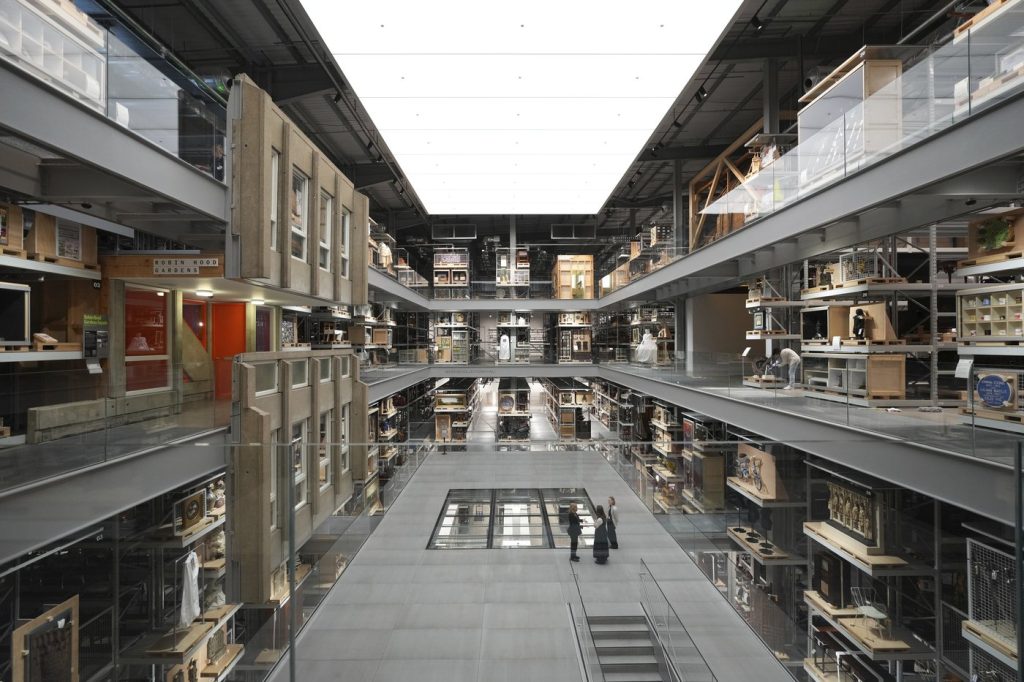LONDON (AP) – Museums often resemble icebergs, with a majority of their collections hidden from public view. Traditionally, most large museums display only a small portion of their items, while the rest remain stored away. However, the newly launched V&A East Storehouse, a branch of London’s Victoria and Albert Museum, takes a different approach by inviting visitors to explore its storerooms, where they can view and, in many cases, touch a variety of items.
Spanning 16,000 square meters (170,000 square feet), the V&A East Storehouse is larger than 30 basketball courts and houses over 250,000 objects, 350,000 books, and 1,000 archives. The vast three-story hall gives visitors a unique experience reminiscent of wandering through a furniture store, yet every corner holds artistic treasures ranging from ancient Egyptian footwear to Roman pottery, Japanese armor, and even a vintage Piaggio scooter.
Kate Parsons, the museum’s director of collection care and access, described the collection as representing “5,000 years of creativity.” The relocation of the stored items from a previous facility in west London took over a year and involved 379 truckloads.
Among the most innovative features is the “Order an Object” service, allowing anyone to book a personal appointment with a specific item, from a Vivienne Westwood sweater to a delicate Japanese netsuke figurine. Many items can be handled, although certain hazardous materials, like Victorian wallpaper containing arsenic, are exceptions. In showcasing this personal interaction with artifacts, Parsons highlighted a popular item: a pink silk taffeta evening gown designed by Balenciaga in 1954.
Public response has been overwhelmingly positive since the storehouse opened in late May, with a diverse range of visitors, including art students and brides-to-be. Some even bring specialized equipment to study specific details of the items on display, fostering spontaneous conversations among attendees. Parsons remarked on the engaging atmosphere, expressing her delight at the public's enthusiastic embrace of this newly conceptualized space.
The V&A's primary museum, established in the affluent South Kensington area in the 1850s, is a major tourist destination in Britain. In contrast, the Storehouse is situated in the Olympic Park, a revitalized area of east London that was the site of the 2012 Summer Games. As part of the post-Olympic redevelopment, this area is transforming into a cultural hub, featuring art and fashion colleges, a dance theater, and plans for another V&A branch expected to open next year. The Storehouse has also actively recruited young people from local communities, contributing to its integration within the surrounding neighborhoods.
Designed by the acclaimed firm Diller, Scofidio and Renfro, known for the High Line park in New York, the building includes space for large artifacts that are seldom displayed, such as a 17th-century Mughal colonnade, a modernist office designed by Frank Lloyd Wright from the 1930s, and a monumental stage curtain by Pablo Picasso for a 1924 ballet.
Additionally, significant architectural remnants, such as a gilded 15th-century ceiling from Spain’s Torrijos Palace and a segment of the concrete façade from the demolished Robin Hood Gardens in London, are also on view. Rather than being a quiet venue for contemplation, the Storehouse operates as a lively working facility where conversations thrive amid the background hum of activity.
Another innovative aspect is the initiative aimed at unveiling the museum’s inner workings. The Storehouse includes displays that showcase the conservation process, the ongoing battles against physical and environmental threats to artifacts, and offers visitors a viewing gallery to observe museum staff at work.
This heightened transparency comes in response to growing scrutiny faced by UK museums regarding the origins of their collections. Many institutions are under pressure to address the controversial acquisition of objects during the British Empire's colonial past. Georgia Haseldine, a senior curator at the V&A, emphasized the museum's commitment to transparency, ensuring that provenance is openly discussed and that equitable access to the collection is provided for researchers and the general public alike.
On average, museums worldwide exhibit merely one to five percent of their collections. The V&A East Storehouse argues this should not be the case, asserting that its national collection belongs to everyone and that public access is paramount.










